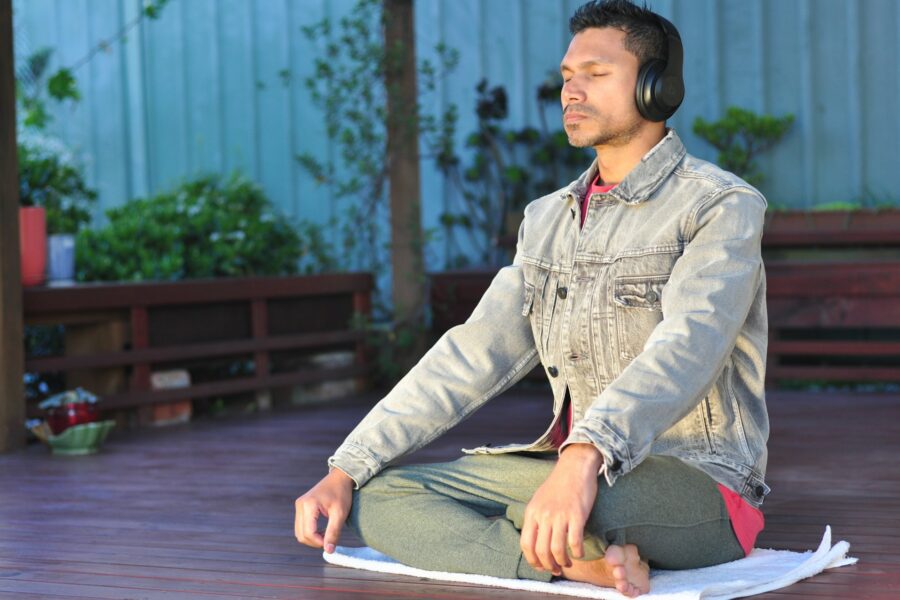Meditation often gets sold as sitting silently for half an hour with a clear mind and a serene smile.

For people with ADHD, that version sounds nearly impossible. However, that doesn’t mean meditation isn’t for you—it just means you need a version that actually fits how your brain works. Here’s how to experience the benefits of this practice. As it turns out, they can be even more heightened for neurodivergent people.
1. You don’t have to sit completely still.

Stillness can feel like a trap if your body’s got energy to burn. But meditation isn’t about freezing in place; it’s about building awareness. Movement doesn’t disqualify you from that. Try walking meditation, stretching, swaying, or even fidgeting with something small. If your body’s more engaged, your mind might settle more naturally than if you force stillness from the start.
2. Shorter sessions are completely valid.

If the idea of meditating for 20 minutes makes your skin crawl, you’re not alone. For ADHD brains, shorter is often smarter. Even a few minutes of focused breathing can make a real difference. Start with two to five minutes and build from there if it feels good. Consistency matters more than duration. The win is in showing up, not how long you sit there.
3. You’re allowed to use background noise.

Silence can sometimes feel overwhelming, not calming. If your mind races in quiet, add some low, steady sound—like rain, white noise, or calming instrumental music. That’s not cheating; it’s adapting. The goal isn’t to sit in monk-level silence. It’s to create a mental environment where your focus feels anchored, not scrambled. Background sound can make that a lot easier.
4. Guided meditations are your friend.

Trying to lead yourself through a meditation while also managing a wandering mind is like herding cats with your hands tied. Guided meditations give you structure, cues, and a voice to follow. There are tons of options—from body scans to grounding exercises—and many are under ten minutes. The voice acts like a tether, gently keeping you connected when your focus starts drifting.
5. Fidget tools aren’t a distraction—they’re support.

If playing with a stress ball, fidget cube, or textured object helps keep you from bouncing out of your seat, use it. You don’t have to sit statue-still to be mindful. Some people actually focus better with a physical outlet. Your hands stay busy, your mind stays engaged, and the experience becomes less about restriction and more about rhythm.
6. Mindfulness doesn’t always mean sitting down.

Meditation can happen while you walk, clean, doodle, or even cook. It’s about being present, not motionless. You can bring awareness into whatever you’re already doing. Focus on your steps, your breath, your senses—what you can feel, see, or hear in the moment. That’s still meditation. It just looks different from the usual cross-legged picture.
7. You’re not doing it wrong if your mind wanders.

The point isn’t to never get distracted—it’s to notice when it happens and gently bring your focus back. That noticing is the practice, not a sign you’ve failed. If you spend the whole session bringing your mind back 50 times, that’s still meditation. ADHD brains just take more trips, and that’s okay. Each return builds your focus muscle.
8. Movement-based breath work might feel more natural.

Sitting and focusing on your breath can feel a bit flat. But adding movement—like stretching while you inhale or exhale—can help ground your attention in something physical. It creates a rhythm that’s easier to follow and adds a sense of flow. Think of it as giving your focus something to hold onto, rather than letting it float around aimlessly.
9. You don’t need to clear your mind.

That idea of emptying your brain? Completely unrealistic for most people—especially with ADHD. Your mind will stay active, and that doesn’t mean you’re doing it wrong. The goal isn’t silence, it’s awareness. Noticing what thoughts come up, letting them pass, and coming back to the moment is where the benefit is. A noisy mind doesn’t cancel out the process.
10. Try anchoring with your senses.

If breath focus doesn’t work for you, try using your senses instead. Notice the weight of your body in the chair, the temperature of the room, or the sounds around you. Pick one and really tune into it. This can help keep your attention grounded in your body rather than spinning out in your head. Sensory focus tends to feel more tangible and less abstract, which is helpful when your brain’s moving fast.
11. Use visualisation to give your brain something to play with.

Visualising something—a place, a colour, a gentle scene—can be more engaging than just trying to “be still.” It gives your brain an internal movie to follow, which can actually be really calming. Picture walking through a forest, watching a candle flicker, or floating in water. This kind of imagery can hold your focus in a way that feels less rigid and more creative.
12. You can meditate lying down, sitting, or standing.

There’s no gold-star position you have to master. Some people concentrate better lying down, while others need to stand or pace to stay focused. It’s not about posture; it’s about presence. Experiment until something feels natural. Just because it doesn’t look like a meditation app ad doesn’t mean it isn’t working. Your version gets to look however it needs to.
13. Routine helps, but flexibility is key.

Setting a time each day to meditate can help build consistency, but if one day you only manage two minutes, or have to do it standing in your kitchen instead of sitting on a cushion—that still counts. Don’t let the perfect setup become another barrier. ADHD-friendly meditation works best when it adapts with you, not against you. Keep it flexible so it can keep fitting into your real life.
14. Meditation might not feel ‘relaxing’ right away, and that’s okay.

Especially at first, it can feel boring, frustrating, or like you’re just sitting with a loud brain. That doesn’t mean it’s not working; it means you’re noticing what’s usually buried under the noise of your day. Stick with it gently. You don’t need to chase calm—you’re just building space in your brain. The peace comes in layers, not all at once, and it’s worth giving yourself the time to get there.


